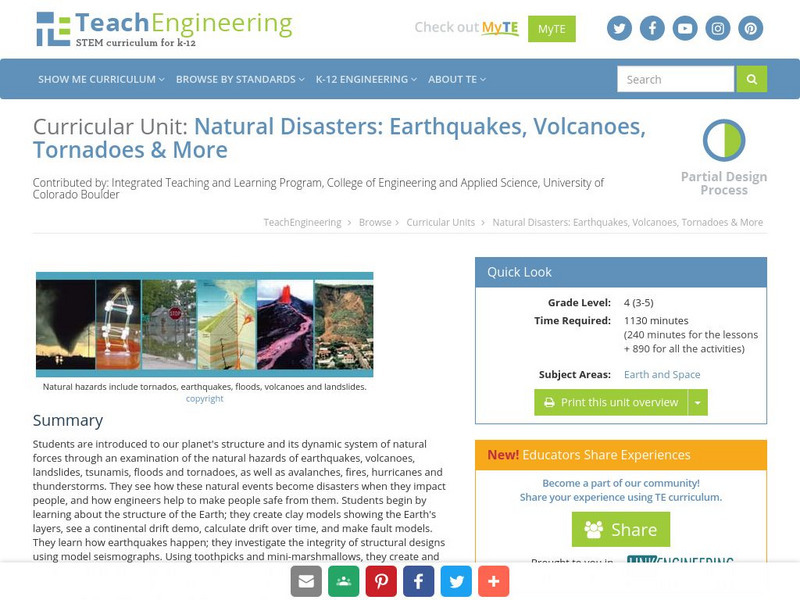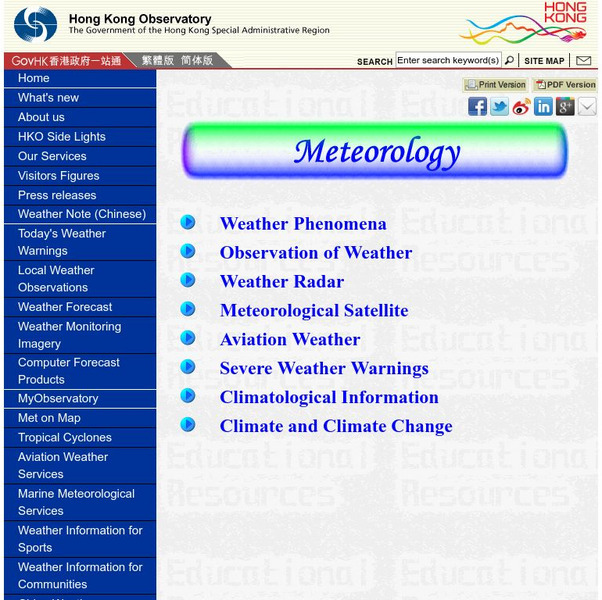TeachEngineering
Teach Engineering: Natural Disasters
Students are introduced to our planet's structure and its dynamic system of natural forces through an examination of the natural hazards of earthquakes, volcanoes, landslides, tsunamis, floods and tornados, as well as avalanches, fires,...
Children's Museum
The Children's Museum of Indianapolis: Weather: Twirly Whirly Tornado
In this instructional activity, learners will witness the creation of a funnel, observe how a funnel moves debris, and learn how a thunderstorm can create tornados.
Other
Hong Kong Observatory: Meteorology
A useful page from the Hong Kong Observatory offering introduction to weather and weather phenomenon. Learn about thunderstorms, tides, monsoon season, weather radar, and weather in space. Not a slick site but informative. Most...
NOAA
Noaa: Owlie Skywarns Weather Book [Pdf]
Download and print this free activity book about hurricanes, tornadoes, lightening, floods and winter storms. A quiz section is also included.
The Field Museum
Field Museum: Exhibits: Nature Unleashed: Inside Natural Disasters
Discover the true powers of Mother Nature through this vivid collection of research which delves into the causes of natural disasters and the impacts on those affected.
University Corporation for Atmospheric Research
Ucar: How Tornadoes Form
Only about one thunderstorm in a thousand produces tornadoes. Learn how tornadoes form.
TED Talks
Ted: Ted Ed: The Most Lightning Struck Place on Earth
Lake Maracaibo is the stormiest place on the planet. Thunderstorms rage above this massive body of water for up to 200 days of the year, with each ear-splitting event lasting for several hours. Graeme Anderson lists the factors that...
TED Talks
Ted: Ted Ed: How Do Tornadoes Form?
Meteorologist James Spann sheds light on the lifespan of tornadoes as they go from supercell thunderstorms to terrible twisters before eventually dissolving back into thin air. [4:11]
Other
Kidstorm: Lightning
Learn about lightning formation and lightning safety with this detailed webpage.
Science Struck
Science Struck: Different Types of Storms
Provides descriptions of a variety of storm types including wintry ones, ones with no precipitation, and very destructive ones. Discusses weather conditions that lead to these storms, precautions one can take, public alerts, etc.
Curated OER
Weather Dude: Thunder and Lightning
Weather site highlights the severe weather occurrences of thunder and lightning. Click on the link to hear a music clip.
NOAA
Noaa: Photo Library: Lightning Photo 3
The National Oceanic and Atmospheric Administration provides a photo library of severe weather formations. Utilizing time-lapse photography, this image captures numerous cloud-to-ground lightning strikes during a nighttime thunderstorm...
NOAA
Noaa: Photo Library: Lightning Photo 6
The National Oceanic and Atmospheric Administration provides a photo library of severe weather formations. This photograph captures several lightning strikes during an early evening thunderstorm.
NOAA
Noaa: Photo Library: Lightning Photo 2
The National Oceanic and Atmospheric Administration provides a photo library of severe weather formations. Utilizing time-lapse photography, this photograph captures multiple cloud-to-ground lightning strokes during a nighttime...
NOAA
Noaa: Photo Library: Lightning Photo 4
The National Oceanic and Atmospheric Administration provides a photo library of severe weather formations. Using time-lapse photography, this image captures numerous cloud-to-ground lightning strokes during a nighttime thunderstorm in...
NOAA
Noaa: Photo Library: Lightning Photo 5
The National Oceanic and Atmospheric Administration provides a photo library of severe weather formations. Originally appearing in National Geographic Magazine, this photograph captures a lightning strike above Norman, Oklahoma.
Other
American Red Cross: Masters of Disaster: Grades 6 8
This resource presents many science lessons with related activities for middle schoolers in grades 6-8. Content addresses tools for coping with disasters such as tornadoes, fires, lightning, floods and general preparedness.
NOAA
Noaa: Photo Library: Lightning Photo 1
The National Oceanic and Atmospheric Administration provides a photo library of severe weather formations. This photograph is of several strokes of lightning striking during a nighttime thunderstorm.
TeachEngineering
Teach Engineering: Tornado!
Students learn about tornadoes - their basic characteristics, damage and occurrences. Students are introduced to the ways that engineers consider strong winds, specifically tornadoes, in their design of structures. Also, students learn...
American Museum of Natural History
American Museum of Natural History: Tornadoes O Logy Card
Flip this interactive card to start learning about tornadoes, nature's most powerful storms. Answer multiple-choice and fact-or-fiction questions and review some fast facts about tornadoes.
Other
Kean: Weather Systems [Pdf]
No scientific phenomena concern us as much as the daily evolution of weather systems. We live in a culture where weather, the state of the atmosphere at a given time and place,helps us define regional cultural variations. States such as...
Science4Fun
Science4 Fun: Tornado
Explore how tornadoes are formed, learn about the parmeters of a tornado, discover the different types, and find out where they occur.











